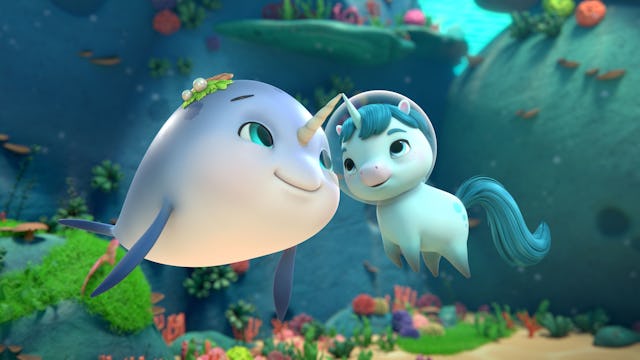Not Quite Narwhal Is The Colorful & Casually Inclusive New Series Your Kid Is Going To Love
A show encouraging kids to “embrace the whole you”? Yes!

What do you get when you cross a unicorn and a narwhal? While this may sound like the start of a kids’ joke, it’s actually the premise of the adorable DreamWorks series Not Quite Narwhal coming to Netflix on June 19. And if you’re familiar with the New York Times-bestselling children’s book of the same name by Jessie Sima, you know the answer: Kelp! As in the adventurous, dual-identity-embracing, wildly endearing unicorn-narwhal hybrid at the heart of this new show.
“Curious and fun-loving Kelp has always believed he's a narwhal like the rest of his family under the sea, until the day he makes the most amazing discovery — he’s actually a unicorn!” reads the show’s logline. “Rather than choose one or the other, Kelp embraces being both a narwhal and a unicorn, juggling his day-to-day life as he figures out how to navigate his two worlds: the ocean and land.”
So, if you’re keeping track, you’ve already got (1) a series based on a beloved children’s book, (2) starring a character that combines two iconic creatures, which (3) takes place in both the ocean and the most fantastical unicorn land one could ever imagine. What preschooler wouldn’t want to watch that?
Your preschooler won’t be the only one who quickly develops an obsession with Not Quite Narwhal, though. Scary Mommy has the exclusive trailer debut for the series to reel in the whole fam:
As a parent, you probably picked up on a few things — like the fact that the creatures who inhabit this fantastical universe have different hair textures. Or how the characters call being different “interesting” and “rad.”
That casual inclusivity (it’s not preachy or overbearing; it’s just there because that’s what inclusivity should look like) can be felt throughout the series. To explore this — and more — Scary Mommy asked co-executive producers Brian K. Roberts, Nakia Trower Shuman, and Sarah Katin a few questions.
Very early, the message emerges that being different isn’t something to be ashamed of; it’s something to be celebrated. For kids today, why do you think that’s so important to hear?
Nakia: With all the social media around kids today, I think it’s probably more important than ever. Kids are, even unintentionally, comparing themselves to each other. It’s beyond sad that kids feel they need to put their energy into being like someone else, instead of honing that energy into loving themselves and celebrating the very person they are. To understand how special it is to be you. Anything we can do to help change the conversation in this direction, I feel, is important.
Sarah: We can all relate to this. Who hasn’t felt “different” or “other” at some point in their life? And if any kid (or adult, for that matter) starts to embrace what makes them unique and special instead of feeling bad about it, well, that’s why it’s important to hear.
One thing we noticed immediately was all of the different hairstyles and textures, which is so refreshing to see in an animated series. What are some other examples of inclusivity in the series?
Brian: Since embracing your own uniqueness is at the heart of Jessie’s book, we wanted to fill the world with characters who showcased a lot of uniqueness. The hairstyles you noticed are an important part of that. In addition to making sure the characters and the amazing cast who voiced them are ethnically and racially diverse and gender-balanced, we also have lots of other uniqueness. There’s a character who communicates nonverbally, one who has low vision, and unicorns and dolphins with limb differences. It’s something we wanted to get right, so we spent a lot of time talking about it with the help of childhood development, disability, and cultural consultants. This gives us a wide spectrum of characters that lots of kids can identify with without falling into tokenism or making the inclusion feel shoehorned in.
Love this idea that you don’t have to choose. Kelp doesn’t have to be a narwhal or a unicorn… he can be both! How do you hope this resonates with young viewers?
Sarah: I think we have a tendency to put people in boxes. This or that. Pick one. But the truth is there are myriad ways to be and live. You don’t have to choose one. You can choose to be all of yourself, and I think kids have a good role model in Kelp for that.
Is there anything else you’d like viewers to know?
Nakia: We hope that they have so much fun watching and joining Kelp and his friends on their adventures and that Not Quite Narwhal finds a special place in their hearts and homes in the same way that it has ours.
Brian: Though the show is right in the sweet spot for preschoolers, we also set out to produce a show that made ourselves laugh and get excited and have all the feels — without ever being grating or saccharine. My teenagers even enjoy watching it! I think families can benefit from watching the episodes all together and talking about how the situations and feelings that the characters experience may relate to their own lives.
Sarah: In the end, we’re telling stories to entertain. So, I hope kids find great joy in Kelp and his adventures below and above the water. And, if they also pick up on some of the themes of embracing differences and being yourself, well, that’s just gravy. It’s like our fabulous development exec Vanessa Taylor Sands, who championed this project from the start, said: ‘It’s Zumba. You’re having so much fun you might not even realize you’re getting exercise too.’
Watch Not Quite Narwhal when it hits Netflix on June 19.